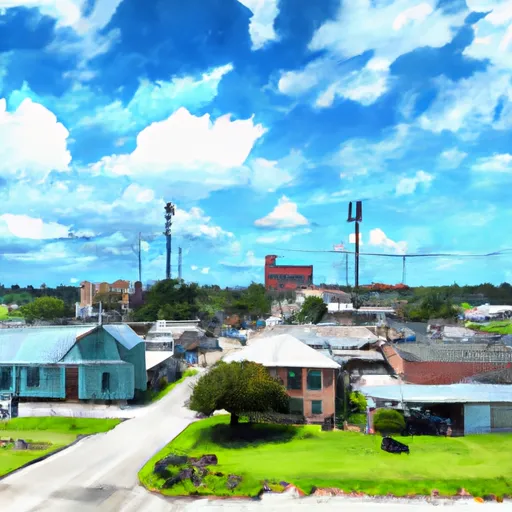-
 Snoflo Premium
Snoflo Premium
Get unlimited access to all our content
With no Ad interruptions! - Start Your Free Trial Login with existing account
Mulberry
Eden Index
Climate
6.7
•
Recreation
5.1
•
Community
1.5
•
Safeguard
4.8/10

Mulberry, Florida is a charming town located in Polk County, known for its pleasant climate, diverse hydrology constituents, and abundant outdoor recreation opportunities. The town experiences a typical Florida climate, with hot and humid summers and mild winters. Average temperatures range from the mid-70s to mid-90s Fahrenheit during summer and the 50s to 70s Fahrenheit in winter.
Mulberry is surrounded by various hydrological features, including lakes, rivers, and wetlands. The Alafia River and Blackwater Creek are prominent water bodies in the area, offering opportunities for fishing, kayaking, and boating. The region is also known for its phosphate mining history, resulting in numerous lakes and reclaimed areas that provide a unique landscape for exploration.
Outdoor enthusiasts can enjoy activities such as hiking, bird-watching, and wildlife spotting in Mulberry's several nature parks. The Alafia River State Park and the Circle B Bar Reserve are popular destinations, showcasing diverse ecosystems and a plethora of plant and animal species.
In conclusion, Mulberry, Florida offers a pleasant climate, diverse hydrology constituents, and a range of outdoor recreation opportunities. Whether it's enjoying water activities, exploring natural parks, or simply appreciating the beautiful surroundings, Mulberry has something to offer for nature lovers and adventurers alike.
What is the Eden Index?
The Snoflo Eden Index serves as a comprehensive rating system for regions, evaluating their desirability through a holistic assessment of climate health, outdoor recreation opportunities, and natural disaster risk, acknowledging the profound impact of these factors on livability and well-being.
Climate Health Indicator (CHI): 6.7
Mulberry receives approximately
1331mm of rain per year,
with humidity levels near 86%
and air temperatures averaging around
23°C.
Mulberry has a plant hardyness factor of
9, meaning
plants and agriculture in this region tend to thrive here all year round.
By considering the ideal temperature range, reliable water supplies, clean air, and stable seasonal rain or snowpacks, the Climate Health Indicator (CHI) underscores the significance of a healthy climate as the foundation for quality living.
A healthy climate is paramount for ensuring a high quality of life and livability in a region, fostering both physical well-being and environmental harmony. This can be characterized by ideal temperatures, reliable access to water supplies, clean air, and consistent seasonal rain or snowpacks.
Weather Forecast
Streamflow Conditions
Tampa Bay
Area Rivers
Tampa Bay
Snowpack Depths
Tampa Bay
Reservoir Storage Capacity
Tampa Bay
Groundwater Levels
Recreational Opportunity Index (ROI): 5.1
The Recreational Opportunity Index (ROI) recognizes the value of outdoor recreational options, such as parks, hiking trails, camping sites, and fishing spots, while acknowledging that climate plays a pivotal role in ensuring the comfort and consistency of these experiences.
Access to outdoor recreational opportunities, encompassing activities such as parks, hiking, camping, and fishing, is crucial for overall well-being, and the climate plays a pivotal role in enabling and enhancing these experiences, ensuring that individuals can engage in nature-based activities comfortably and consistently.
Camping Areas
| Campground | Campsites | Reservations | Toilets | Showers | Elevation |
|---|---|---|---|---|---|
| Alafia River State Park | None | 117 ft | |||
| Gores Landing County Park | None | 31 ft | |||
| Fore Lake | 100 | 82 ft | |||
| Edward Medard | None | 79 ft | |||
| Santos Rec Area State Park | 24 | 74 ft | |||
| Lake Griffin State Rec Area | None | 85 ft | |||
| Silver River State Park | 59 | 63 ft | |||
| Withlacoochee River Park | 10 | 94 ft | |||
| Big Bass | 34 | 69 ft | |||
| Saddle Creek County Park | None | 111 ft |
Catastrophe Safeguard Index (CSI):
The Catastrophe Safeguard Index (CSI) recognizes that natural disaster risk, encompassing floods, fires, hurricanes, and tornadoes, can drastically affect safety and the overall appeal of an area.
The level of natural disaster risk in a region significantly affects safety and the overall livability, with climate change amplifying these risks by potentially increasing the frequency and intensity of events like floods, fires, hurricanes, and tornadoes, thereby posing substantial challenges to community resilience and well-being.
Community Resilience Indicator (CRI): 1.5
The Community Resilience Indicator (CRI) recognizes that education, healthcare, and socioeconomics are crucial to the well-being of a region. The CRI acknowledges the profound impact of these elements on residents' overall quality of life. By evaluating educational resources, healthcare accessibility, and economic inclusivity, the index captures the essential aspects that contribute to a thriving community, fostering resident satisfaction, equity, and social cohesion.

